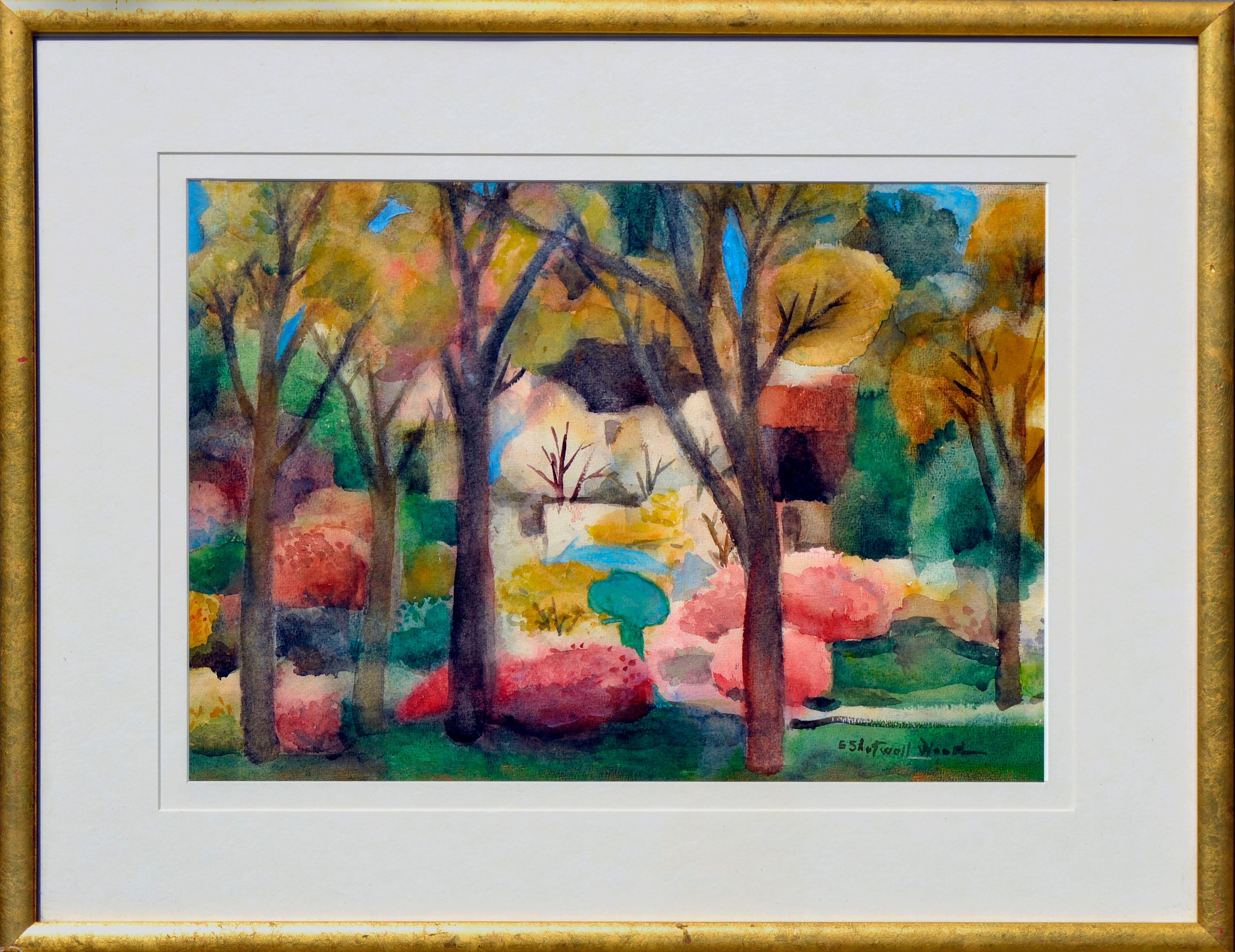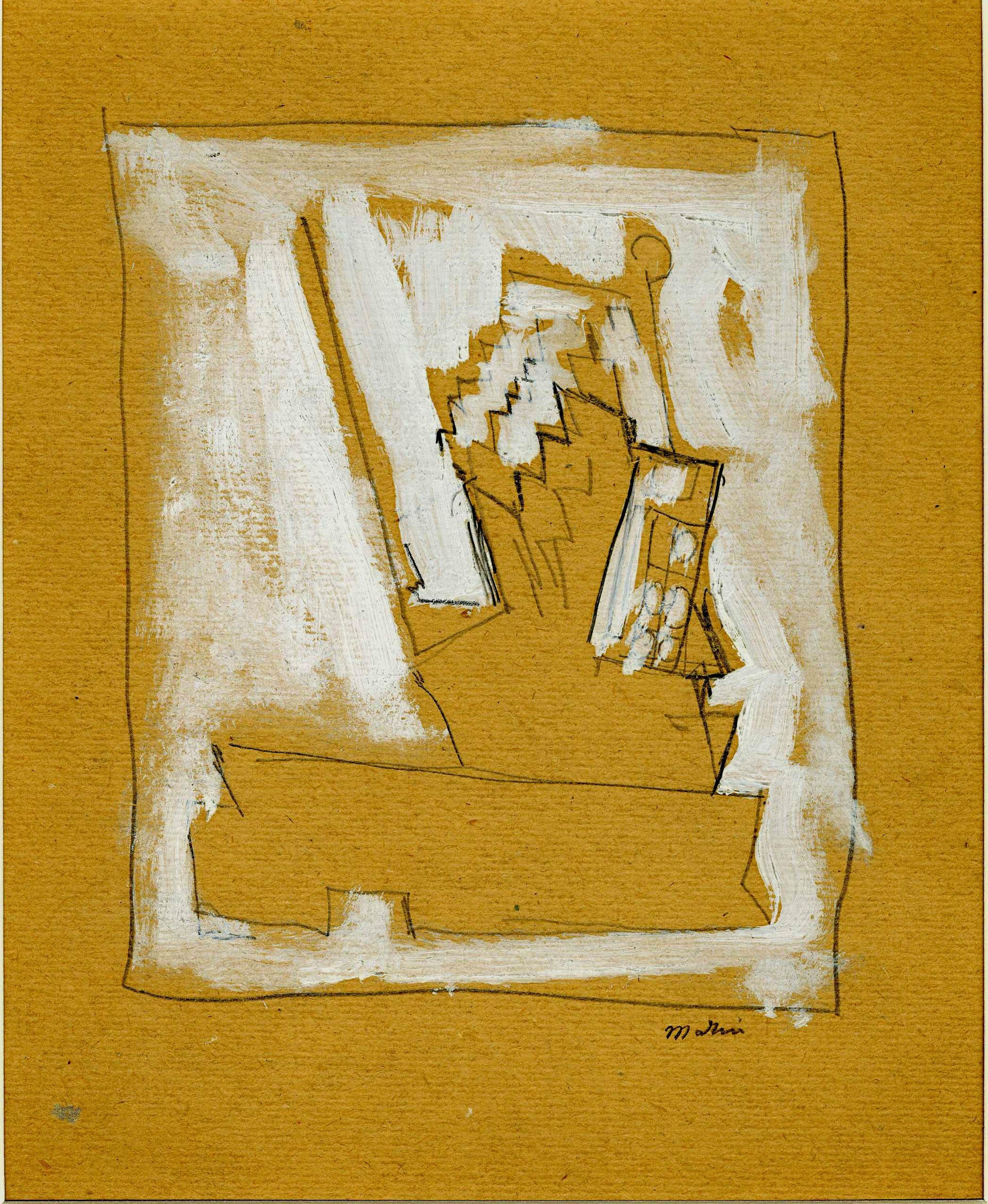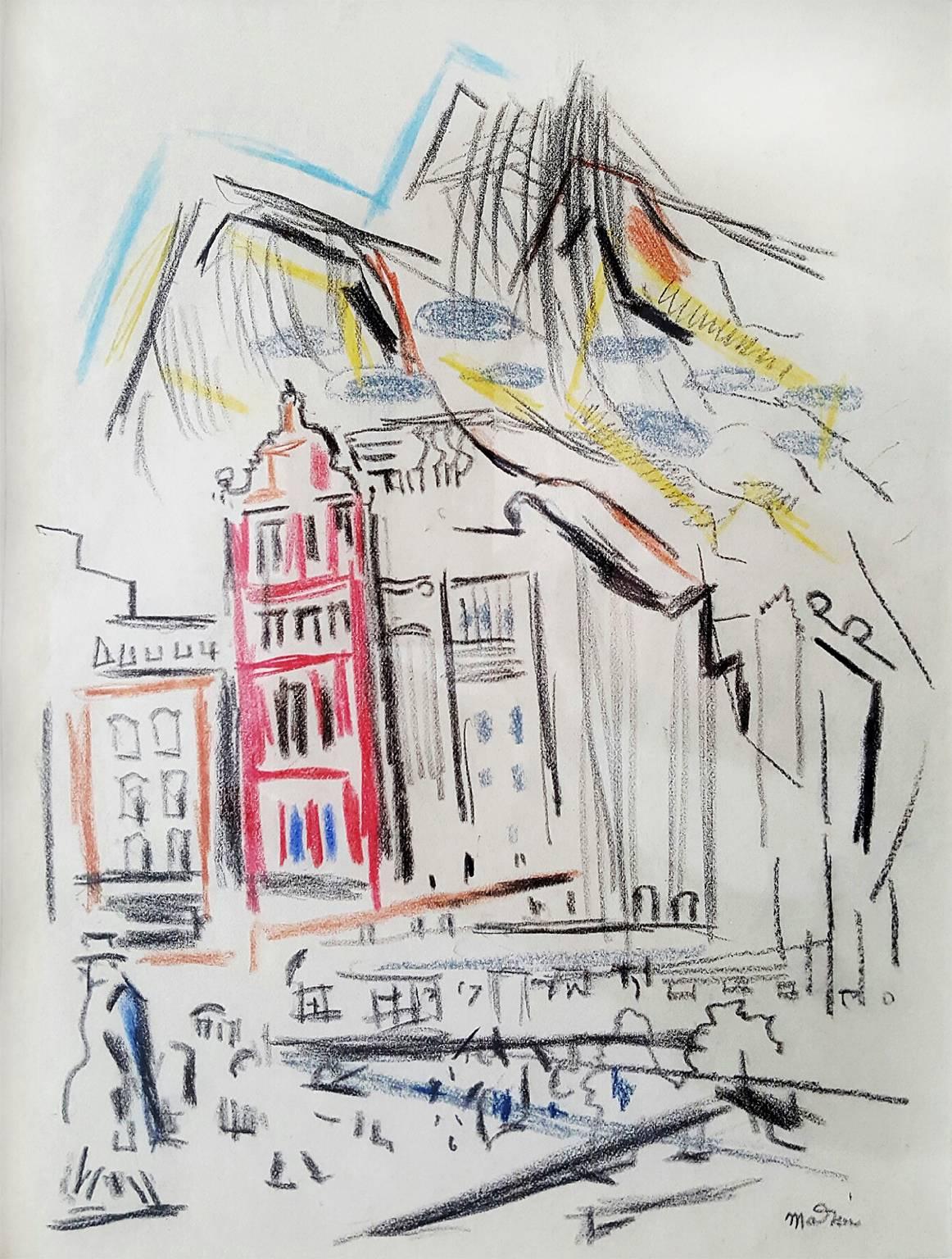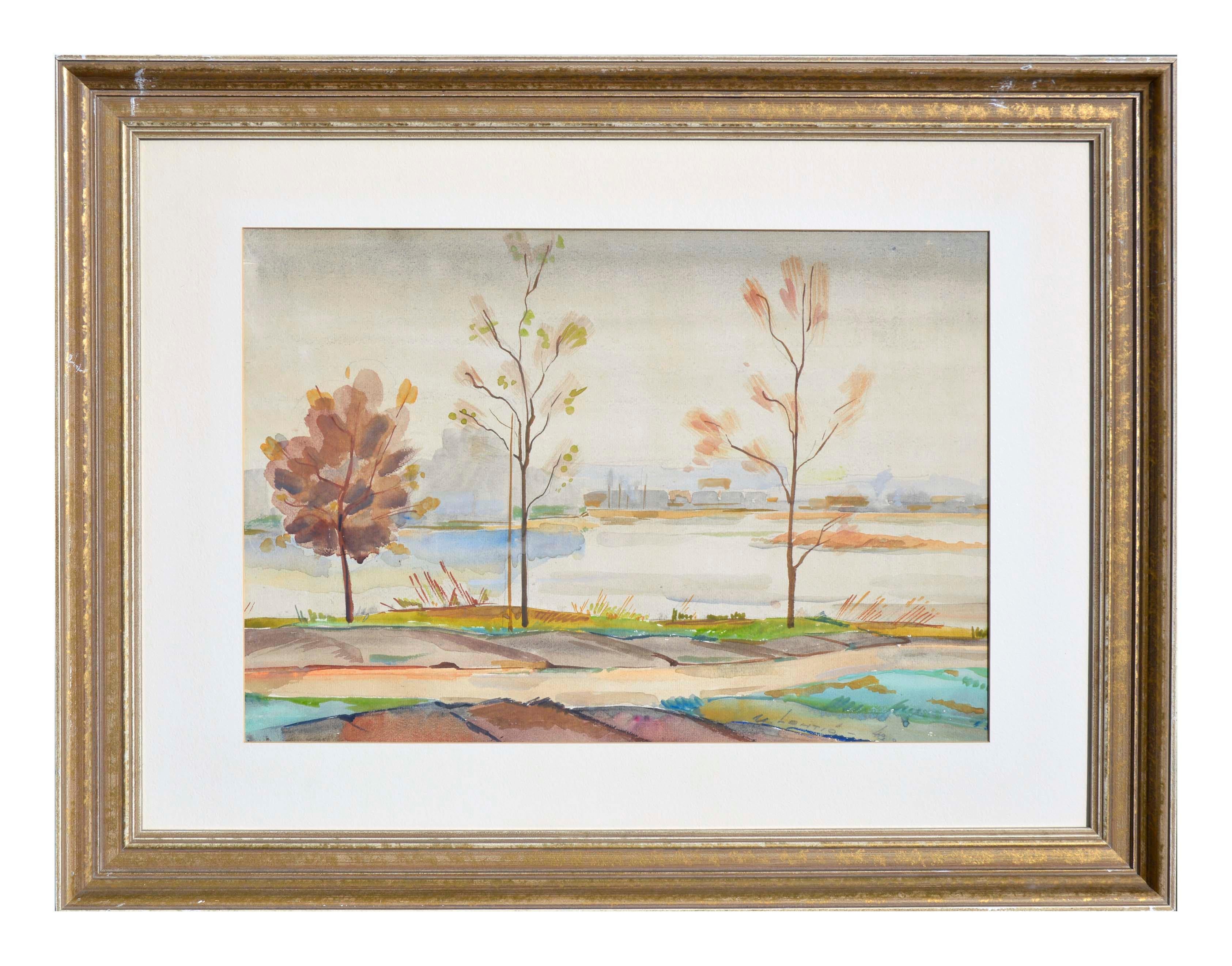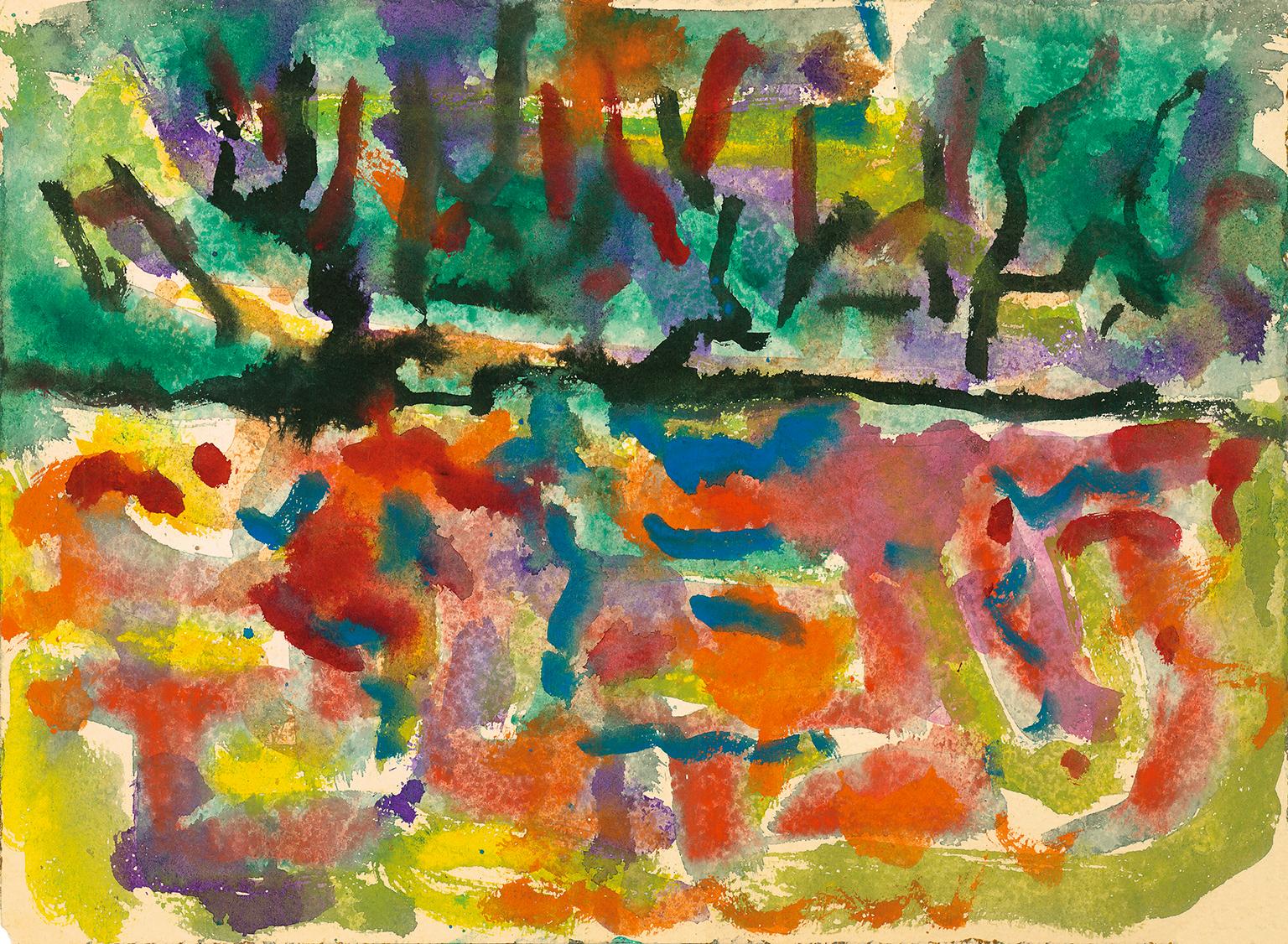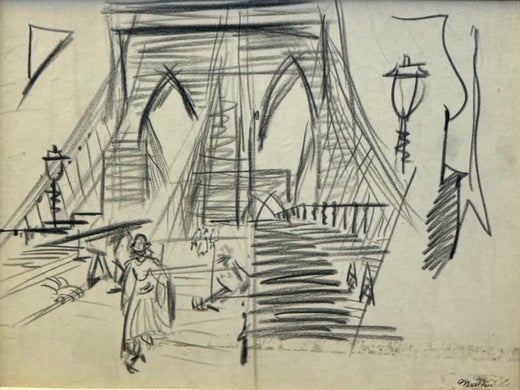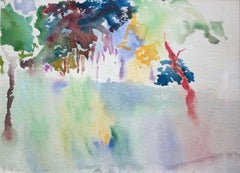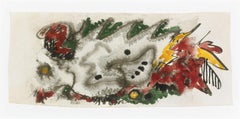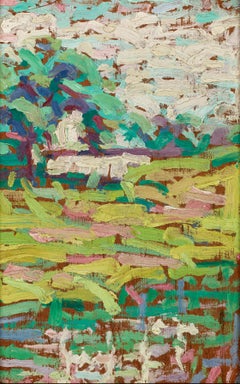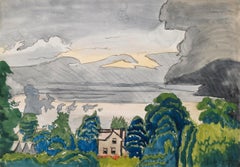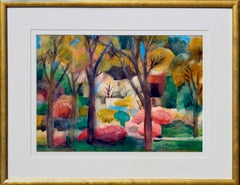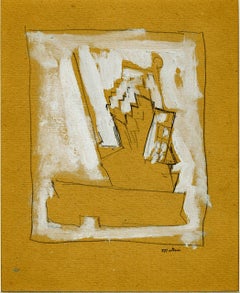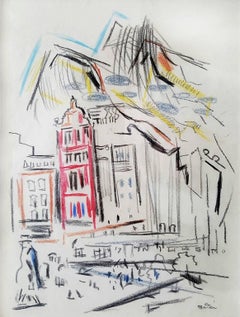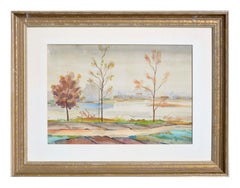Items Similar to Maples in Autumn Foliage
Want more images or videos?
Request additional images or videos from the seller
1 of 8
John MarinMaples in Autumn Foliage1949
1949
$95,000
£72,135.75
€82,492.62
CA$132,728.78
A$147,623.37
CHF 77,084.34
MX$1,796,419.41
NOK 984,484.62
SEK 923,272.89
DKK 615,674.01
Shipping
Retrieving quote...The 1stDibs Promise:
Authenticity Guarantee,
Money-Back Guarantee,
24-Hour Cancellation
About the Item
John Marin’s long and prolific career is best marked by his fervent love of painting and abiding belief that art must relate to lived experiences. His best work strikes a delicate balance between abstraction and reality. His commitment to conveying the “realness” of a given subject through an abstract vocabulary of line, shape, color and texture is what defines his artistic singularity. Marin’s work never lost its vigor, even as he returned to the same themes and places over the course of his life. With each return he investigated a subject anew and applied his unflagging creativity and innovation to convey the full force of his experience and imagination.
Marin is one of those unique artists who would have been great whether or not he had any formal art training, as his passion for and commitment to his work was unflagging even as his health failed at the end of his life. His interest in drawing began when he was young, and he initially honed his skill in mechanical drawing at the Stevens Institute of Technology. He then worked as an architectural draftsman and even set up his own firm. Marin abandoned this pursuit by 1897, and by 1899 he had enrolled at the Pennsylvania Academy of the Fine Arts, where he would study until 1901. He probably did not spend a lot of time in class; in fact, he might have taken night courses, which would have allowed him to roam around Philadelphia for countless hours making sketches of the city—an exercise that would be lifelong. In 1900 he was awarded a prize at the Academy for an outdoor sketch.
Marin met Alfred Stieglitz in 1909. The relationship and friendship the two men would share until Stieglitz’s death in 1946 was formative for both. Stieglitz exhibited Marin’s work more than any other of his artists except for Georgia O’Keeffe. His support of Marin’s career was crucial to the artist’s extraordinary productivity and enormous popularity with critics and collectors alike. The acclaim that Marin received during his lifetime surpassed all of his contemporaries.
Marin was a rugged individualist; it informed his life and art. He developed a singular working method and artistic style that he consistently built upon throughout his career. Line was essential to his artistic practice, and drawing was as “natural as breathing.” Marin’s first experiments with abstraction took place in the 1910s, and even as his vocabulary became more abstract, he did not abandon his insistence on the primacy of nature. Unlike many of his peers, Marin never delved into pure abstraction and instead retained some recognizable imagery.
Marin’s two principle subjects, the landscape and the city, provided him with endless inspiration, with his experience in one setting informing and influencing his experience of the other. The landscape was foremost for Marin, and he was deeply connected to Maine. His landscapes are fresh with his love of paint and fresh with discovery and vibrance. The staccato marks of form and line and the explosions of color are very much connected to his great love for music. Indeed the feeling and energy that Marin conveys in his landscapes are similar to the abstract nature of music itself.
Marin painted Maples in Autumn in 1949. Like his other landscape paintings, he beautifully captures the restless energy of the natural world. He took the scene directly from nature, but never intended to merely transcribe it. Instead, his goal was to capture nature’s spirit and the experience he had in it. The line in this work and others of this period is more calligraphic and less sharp. There is something legato and cheerful about the way he paints the scene, and the riot of red leaves bursts with vitality. Marin’s work at its finest is lyrical and full of feeling. Maples in Autumn is a wonderful example of the vibrance that defined the artist’s practice and his deep relationship to and experience in the natural world.
- Creator:John Marin (1870-1953, American)
- Creation Year:1949
- Dimensions:Height: 19.25 in (48.9 cm)Width: 14.5 in (36.83 cm)
- Medium:
- Movement & Style:
- Period:
- Condition:This work is in excellent original condition with no visible evidence of foxing or acid burn to the surface of the paper. Pigments are vibrant, and there is no evidence of fading due to light exposure.
- Gallery Location:Bryn Mawr, PA
- Reference Number:1stDibs: LU2773216127492
John Marin
John Marin was born in Rutherford, New Jersey in 1870. His father was a public accountant; his mother died nine days after his birth. He was taken to his maternal grandparents with whom he lived in Weehawken, New Jersey. His grandparents, with their son and two daughters were the only parents Marin was to know; it has been suggested that his father seems to have ignored him. As a child of seven or eight Marin began to sketch and when he was a teenager he had completed his earliest watercolors. His education in the schools of New Jersey was interspersed with summers of hunting, fishing and sketching; he traveled in the Catskills, and as far away as Wisconsin and Minnesota. But formal training was almost incidental to his development as an artist. He is to America what Paul Cezanne was to France - an innovator who helped to oppose the influence of the narrative painters, the illustrators who were more interested in subject than form, in surface than substance. Marin brought to his work a combination of values which, at the turn of the century, was unique in this country: an aliveness of touch, colors that have both sparkle and solidity, and forms that are vibrant with an energy characteristic of our age. Marin established himself as a practicing architect. In the early 1890s, he worked for four architects and by 1893 had designed six houses in Union Hill, New Jersey. At the age of twenty-eight, he decided to become a professional artist and studied briefly at the Pennsylvania Academy of Fine Arts in Philadelphia and the Art Students League in New York City. As a watercolorist he had no equal. He used this fluid, spontaneous medium to abstract from objects - skyscrapers, boats, mountains and seas - a simplified anatomy of color and form and to define the pulsation of stresses and movements in the relationship of objects. It was a great disappointment, all his life, that his oil paintings did not achieve the popularity that his watercolors did. From 1905 to 1910 he worked in Europe, where he was influenced by Whistler's watercolors. It was Alfred Stieglitz, Marin's lifetime friend and dealer, whose firm faith in his genius made his position in the art world possible. He developed a distinctive style that he used most characteristically in powerful watercolors of the Maine coast. During the 1920s he provided the dominant force in the movement away from naturalistic representation towards an art of expressive semi-abstraction. He married Marie Jane Hughes after he returned to New York. They had one son, who grew up to run his father's considerable affairs. Marin continued to work at the same steady fast pace as long as he lived. Since 1908 he had produced 1700 paintings, an average of forty a year. He had made the frames for them as well. At the age of seventy-nine, he began to taper off from the days when he painted one hundred watercolors in a summer. He died in 1953.
About the Seller
No Reviews Yet
Recognized Seller
These prestigious sellers are industry leaders and represent the highest echelon for item quality and design.
Established in 2001
1stDibs seller since 2024
Typical response time: 2 hours
- ShippingRetrieving quote...Shipping from: Bryn Mawr, PA
- Return Policy
Authenticity Guarantee
In the unlikely event there’s an issue with an item’s authenticity, contact us within 1 year for a full refund. DetailsMoney-Back Guarantee
If your item is not as described, is damaged in transit, or does not arrive, contact us within 7 days for a full refund. Details24-Hour Cancellation
You have a 24-hour grace period in which to reconsider your purchase, with no questions asked.Vetted Professional Sellers
Our world-class sellers must adhere to strict standards for service and quality, maintaining the integrity of our listings.Price-Match Guarantee
If you find that a seller listed the same item for a lower price elsewhere, we’ll match it.Trusted Global Delivery
Our best-in-class carrier network provides specialized shipping options worldwide, including custom delivery.More From This Seller
View AllLandscape Abstraction
By Arthur Beecher Carles
Located in Bryn Mawr, PA
Initialed lower left
Framed dimensions: 16 x 18 7/8 inches
Provenance
The artist;
Collection of Henry Dubin, Philadelphia until 2018
Exhibitions
Avery Galleries, Bryn Mawr, Pennsylvania, Living Color Modern Life: Hugh Henry Breckenridge and Arthur B. Carles, October 5-November 2, 2018.
The Philadelphia modernist Arthur B. Carles was a brilliant colorist and an extraordinarily innovative painter. Though Carles trained initially at the Pennsylvania Academy of the Fine Arts, soaking up the more conservative teaching of William Merritt Chase and Thomas Anshutz, he was deeply influenced by the avant-garde art scene in Paris during his first trip there in 1905. In 1907, Carles won the prestigious Cresson Traveling Scholarship, which enabled him to return to Paris for several more years. This experience had a profound impact on Carles as an artist; he was extremely affected by modern French painting, especially the work of Cezanne and Matisse, and by the time Carles returned home to Philadelphia in 1912, he was a confirmed modernist.
This small landscape sketch was probably painted early during Carles's career, and yet, it already reveals his strong interest in abstraction. Indeed, Landscape Abstraction demonstrates both his daring exploration of lyrical color harmonies as well as his interest in two-dimensional surface design. Painted loosely in the spontaneous medium of watercolor, Carles used thin washes and delicate pools of paint to suggest the foreground area and surrounding trees. His color palette is rich and expressive, ranging from pale greens and blues to deep red, yellow, and even purple.
In addition to his remarkable career as an artist, Carles was also an incredibly gifted teacher. He taught at PAFA from 1917 to 1925 and had a very deep impact on a number of his students such as Morris Blackburn, Quita Brodhead, and Jane Piper...
Category
20th Century Modern Abstract Drawings and Watercolors
Materials
Watercolor
Italy Goes to War
By Arthur Dove
Located in Bryn Mawr, PA
Provenance
An American Place, New York;
World House Galleries, New York, 1953;
Private collection, New York;
Betty Krulik Fine Art, 2007;
Avery Galleries until present
Exhibitions
An American Place, New York, Exhibition of New Arthur G. Dove Paintings...
Category
1940s American Modern Abstract Drawings and Watercolors
Materials
Paper, Watercolor
Landscape Sketch
By Hugh Henry Breckenridge
Located in Bryn Mawr, PA
Hugh Breckenridge’s artistic training began at the Pennsylvania Academy of the Fine Arts in 1887. The academic precision and attention to detail that mark his portraits and still lif...
Category
Early 20th Century Post-Impressionist Landscape Paintings
Materials
Oil, Board
Lull in Summer Rain
Located in Bryn Mawr, PA
Provenance
Kennedy Galleries, New York;
DC Moore Gallery, New York;
Private collection, Ireland, until 2012
Exhibitions
New York, DC Moore Gallery, Charles Burchfield Paintings, 19...
Category
1910s American Modern Landscape Drawings and Watercolors
Materials
Paper, Watercolor
Autumn Landscape
By Harry Leith-Ross
Located in Bryn Mawr, PA
Provenance
Private collection
Description
Harry Leith-Ross’s Autumn Landscape is a fine example of the spontaneous fluidity of the artist’s painting style. Leith-Ross does not total...
Category
20th Century Landscape Paintings
Materials
Oil
French Scene at Voulangis
By Arthur Beecher Carles
Located in Bryn Mawr, PA
The Philadelphia modernist Arthur B. Carles was a brilliant colorist and an extraordinarily innovative painter. Though Carles trained initially at the Pennsylvania Academy of the Fin...
Category
1920s American Modern Landscape Paintings
Materials
Oil, Board
You May Also Like
Autumn Forest - Mid Century Abstracted Fauvist Landscape
By Emily Shotwell Goeller-Wood
Located in Soquel, CA
Gorgeous mid century fauvist watercolor landscape with lush, vivid trees and distant houses by Emily Shotwell Goeller-Wood (American, 1887-1965). Presented in a rustic giltwood frame...
Category
1940s Fauvist Abstract Drawings and Watercolors
Materials
Paper, Watercolor
Study for Mid-Manhattan II
By John Marin
Located in Fairlawn, OH
Study for Mid-Manhattan II
Oil and graphite on paper, mounted to board, 1932
Signed by the artist in pencil lower right
Sight size: 8 1/2 x 7 inches
One of a series of studies for th...
Category
1930s American Modern Abstract Paintings
Materials
Oil
New York Street Movement and Figure - Architecture
By John Marin
Located in Miami, FL
This work by John Marin depicts an image of lower Manhattan which was Marin's more iconic subject matter. The work has a stellar provenance as well.
Provenance:
Kennedy Galleries
Richard York Gallery
ACA Galleries...
Category
1920s American Modern Mixed Media
Materials
Crayon
Minimalist Mid Century Modern Landscape -- Autumn Trees
Located in Soquel, CA
Minimalist mid-century modern landscape of three autumnal trees by M. Lehtio (American, 20th century). Signed "M. Lehtio" and dated "48." Presented in a wood frame and non-glare glas...
Category
1940s American Impressionist Landscape Paintings
Materials
Watercolor, Laid Paper
Woodland Reflection — Mid-Century Modern
Located in Myrtle Beach, SC
Irving Lehman, Untitled (Woodland Reflection), watercolor, c. 1955. Unsigned, with the artist's estate stamp verso: 'Original Artwork By: IRVING G. LEHMAN Russian/American 1900-1982'...
Category
Mid-20th Century American Modern Abstract Drawings and Watercolors
Materials
Watercolor
Aspen in Fall, 1970s Vintage Autumn Landscape Watercolor
By Lewis Suzuki
Located in Soquel, CA
A vibrant 1970's vintage autumn watercolor landscape scene of an aspen tree with fall foliage by Lewis Suzuki (American, 1920-2016). Artist's signatu...
Category
1970s American Impressionist Landscape Drawings and Watercolors
Materials
Watercolor, Rag Paper
More Ways To Browse
Red Line Drawings
Artist Marin
Vintage Autumn Leaves
Rebecca Livermore
Ricardo Macarron
Rodolphe Watch
Ronald Woodall
Tom Wern
Victor Wong
Ship Canvas
Portrait Of A Beauty
Abstract Geometric Art Paintings
European Oil Paintings
Oil Painting Of Houses
Narrative Painting
The Helper Painting
Colorized Vintage Photos
Limited Edition Print New York
